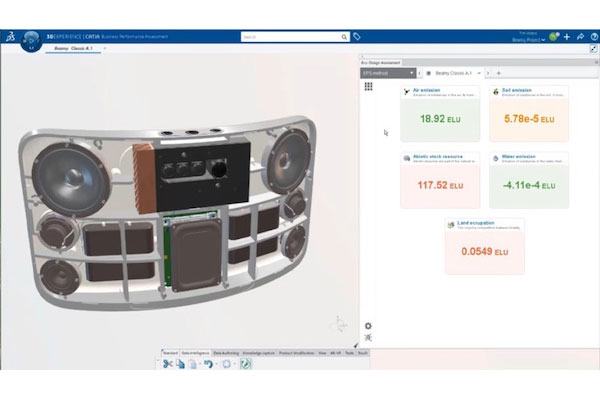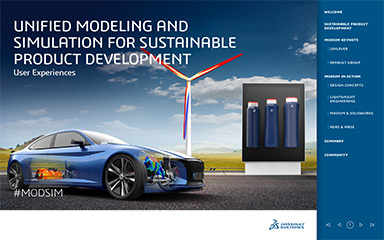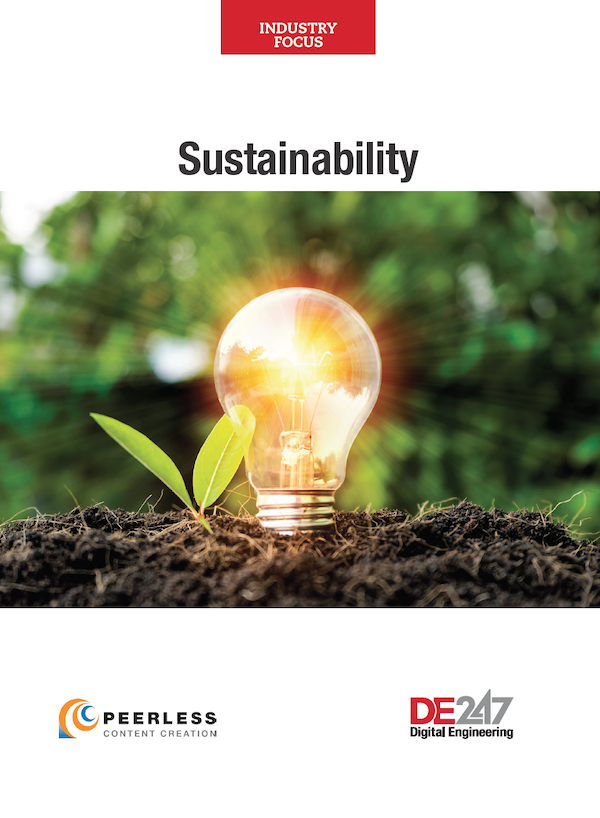Crafting a Sustainable Engineering Culture
Organizations are embracing new tools and seeding new design practices to promote sustainability objectives and build greener products.

Sustainable Innovation Intelligence, an integrated lifecycle assessment tool delivered as part of 3DEXPERIENCE, helps engineers evaluate designs for sustainability metrics. Image courtesy of Dassault Systèmes.
Latest News
July 26, 2022
CEOs and corporate boards have environmental, social and governance (ESG) issues, including sustainability targets, clearly in their sights. Yet sustainability as a common design and engineering best practice is still relatively immature, hamstrung by cultural and organizational obstacles on top of a lack of relevant tools and data.
The calls for a heightened focus on sustainability are coming from all corners. Investors want to align with companies that move the needle on environmentally-friendly business practices, which in turn, channels executive and board action on these issues. At the same time, consumers demand greener products, and employees want to work for companies that represent their values, which for many younger engineers, means a corporate mission tied to sustainability. The global regulatory landscape is prompting companies to get more serious about reducing carbon emissions as well as meeting other sustainability goals.
“Different companies are on different trajectories, but [sustainability] is no longer a ‘nice to have,’” says Joe Speicher, vice president of ESG & Impact for Autodesk Foundation. “Our industries need to be decarbonized—everyone recognizes that. It’s just a question of how and when.”
Like other functional areas, engineering organizations recognize the need to embrace greener design practices, yet many struggle to do so due to a lack of clarity over how sustainability fits into corporate strategy.
According to the Protolabs State of Sustainability in Product Development report, 21% of respondents equate sustainability with doing the right things while 38% tie it to product strategy. Even when there is a clear product directive around sustainability, engineering organizations struggle with other design factors, including how to balance quality and cost, cited by 26% of Protolabs survey respondents, followed by designing and producing new sustainable products (25%), and creating relevant systems and processes (24%).
Organizational culture is another barrier. Less than half (41%) of the Protolabs survey respondents felt sustainability was adequately infused into their engineering culture, let alone well integrated into everyday programs and activities. The report found that CEOs and sustainability officers, those primarily responsible for setting the corporate sustainability agenda, are currently more confident that sustainability initiatives are on track to meet desired goals than those actually tasked with policy and objective implementation.
Leaders who are serious about sustainability must do more than pay lip service to a broad and amorphous trend. Rather, they need to make a concerted effort to ensure their specific sustainability objectives are well understood by everyone in the company, by offering clear directives and expectation setting for different departments and roles.
“All stakeholders must be actors—it can’t just be limited to a domain of experts,” says Bastien Hillen, sustainability strategic engagements senior director at Dassault Systèmes. “That means empowering every employee to understand the impact of their decisions on sustainability and bringing data into context for everyone to assess the optimal solutions.”
Organization Inertia and Culture Clash
Across many engineering organizations, the fear of changing longstanding ways of working is slowing adoption of more sustainable design practices. Engineers, more comfortable solving for traditional design objectives like performance or manufacturability, are skeptical about adding another “design for X” mantra to their already complex design workflows, notes Rein Singfield, senior consulting manager at Kalypso.
In addition, key performance indicators (KPIs) are not closely aligned with stated sustainability outcomes, which creates a disconnect that discourages engineers from prioritizing environmentally-friendly design goals, she adds.
The Protolabs survey confirmed metrics are lacking, with 29% of companies reporting they don’t yet track sustainability-related KPIs.
Many engineering organizations also start thinking about sustainability objectives far too late in the process, when 80% of the environmental impact of a product is locked into the design, according to Gurvinder Singh, global product director, Injection Molding, at Protolabs, an on-demand manufacturing service provider.
“We strive for good trade-off discussions upfront, working with clients to think through whether this part is too complex or this piece too thick,” he says. “These discussions need to move upfront in the design cycle and they need to be had across silos within a company as well as with an expanded supplier ecosystem. Organizations have to think about sustainability holistically.”
Despite these challenges, organizations are making strides. The Protolabs report stated 88% of companies have made changes in product design and sustainability in the last two years and more than half (52%) are focusing sustainability efforts in product design/engineering/innovation.
Among the design practices companies are embracing to advance sustainability initiatives are: integration of artificial intelligence capabilities into design, adoption of design for sustainability workflows, as well as integration of electronics, all cited by 68% of respondents. Roughly three-quarters of companies responding to the survey have formalized sustainability initiatives and established training to upskill engineering teams.

Autodesk partners with Makersite to add lifecycle assessment capabilities to its design tools. Image courtesy of Autodesk.
Tools Help Make Sustainability Count
Materials help design and engineering teams make a dent in sustainability goals. More than half (51%) of respondents to the Protolabs survey said material engineering would help advance sustainability efforts while half pointed to sourcing and procurement strategies.
Plastics such as polybutylene terephthalate (PBT), polyamide (PA) and polyetheretherketone (PEEK) are the top materials used over the last two years and are expected to grow over the next two, according to the majority of respondents to the Protolabs survey. As a result, companies will continue to grapple with balancing cost and quality due to continued use of high-performance plastics.
Part of what’s stopping engineers from making more sustainable materials choices is lack of data, and some design tool vendors are already on the case. Autodesk has partnered with Makersite, a data software firm, on a proof of concept to embed its lifecycle assessment (LCA) capabilities into Autodesk FUSION, which would enable engineers to evaluate a working design’s environment footprint early on in the cycle, Speicher says.
Makersite analyzes a design’s bill of materials based on its data, producing a report on environmental impact drivers, manufacturing costs, compliance issues, even material choices that would optimize the carbon footprint, he explains.
“It provides data related to the supply chain and carbon coefficients of specific materials,” Speicher says.
Dassault Systèmes also recently released its own LCA solution as part of the 3DEXPERIENCE platform. The cloud-based Sustainable Innovation Intelligence solution integrates a database on the impacts of more than 18,000 industrial and agricultural processes to help engineering organizations minimize the environmental impacts of products, materials and processes and helps drive the circular economy.
The real power comes with combining the LCA data with virtual twin technology so stakeholders throughout the design chain fully understand the impact of their choices, aiding in culture change and shifting individual mindsets.
“The big difference is that it’s not a PDF or data in a table,” Hillen says. “Mapping the data with the 3D model is eye-opening for people to better collaborate and understand where the problem is coming from and how to solve it.”
Generative design software and additive manufacturing (AM) are also being leveraged to drive more sustainable product design practices. Companies like Airbus are leveraging generative design capabilities to lightweight parts that exceed performance and safety standards, thus reducing fuel consumption, Speicher says. He also notes that Airbus is using Autodesk’s generative design capabilities beyond making more sustainable airplane parts, to create more sustainable LEED certified factories with streamlined logistics to make the parts.
As AM continues to play a larger role for production parts, companies can advance sustainability goals through better material handling and recycling practices, says Rachel Hunt, 3D printing manager at Protolabs.
“AM, combined with digital manufacturing, allows companies to create virtual inventories where parts are produced on demand in quick-turn fashion,” she says. “This reduces our dependency on large warehouses and leads to a reduction in scrap.”
Whether the sustainability goal involves lightweighting or optimizing material choices, COMSOL makes the case that its Application Builder and COMSOL Apps strategy can help get everyone in the engineering organization—not just simulation experts—on the same page.
Enabling physics experts or PhDs that specialize in water toxicity or energy efficiency to create complex simulation models that can be easily understood and shared with other engineers helps foster a culture around sustainability and encourages designs that move the needle on stated goals.
“People closer to the problem can give feedback to the ones that are smart at physics,” says Phil Kinnane, COMSOL’s senior vice president of sales. “It lets the two groups communicate more effectively through simulation.”
Beyond the tools, engineering organizations must commit to the holistic governance, culture and structural changes that infuse sustainability as a critical design goal into their DNA.
“It’s not just about making a commitment at the C-level or having a dedicated sustainability team lead with changes,” says Autodesk’s Speicher. “Companies need to embed the right KPIs, incentives and compensation into their governance and operating models—that’s the way to drive the cultural change.”
Beth Stackpole is a contributing editor to DE. You can reach her at beth@digitaleng.news.
More Autodesk Coverage
More COMSOL Coverage
More Dassault Systemes Coverage

More Protolabs Coverage
Subscribe to our FREE magazine, FREE email newsletters or both!
Latest News
About the Author
DE’s editors contribute news and new product announcements to Digital Engineering.
Press releases may be sent to them via DE-Editors@digitaleng.news.








